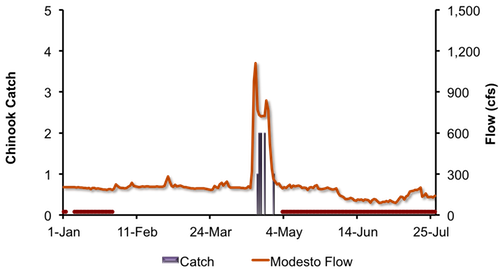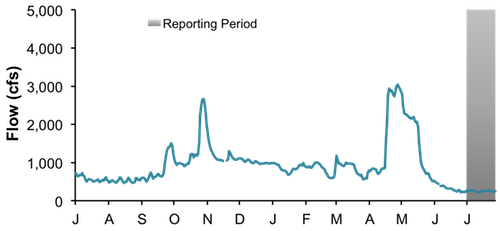|
Volume 2013/14, Issue 17
| August 12, 2014 |
|

ACWA Regulatory SummitAugust 13-14 17th Annual Coho ConfabAugust 22-24
|
|
Key Highlights
June 30, 2014 - July 27, 2014
Juvenile Migration Monitoring concluded for the season at all sites in the San Joaquin Basin between early May and mid-July.
Table 1. Total salmonid catch by site during the 2013/14 San Joaquin Basin juvenile migration monitoring period.
San Joaquin River Conditions.San Joaquin River flow at Vernalis ranged from 211 cfs to 287 cfs. Daily average water temperature in the San Joaquin River ranged from 76.5°F to 80.2°F at Vernalis, and from 78.6°F to 81.6°F at Mossdale. Daily average dissolved oxygen (DO) in the San Joaquin River ranged from 7.5 mg/L to 11.9 mg/L at Mossdale, and from 6.9 mg/L to 8.3 mg/L in the deep-water ship channel (measured at Rough 'n Ready Island).
Delta Exports. Combined total exports (state and federal pumps) fluctuated during the reporting period, ranging from 995 cfs to 2,475 cfs.
|
|
2013/14 Calaveras River Juvenile Migration Monitoring
Stockton East Water District's rotary screw trap monitoring on the Calaveras River at Shelton Road (RM 28) ended for the season on July 11. During the 2013/14 season,  the trap was operated 156 out of 247 days between November 6 and July 11, and a total of 1,108 O. mykiss were captured during the season (Table 1). Most of the O. mykiss captured (n=580) were Age 1+ (100-299 mm), and YOY (n=524; <100 mm). A total of 4 adults (>300 mm) were also captured. the trap was operated 156 out of 247 days between November 6 and July 11, and a total of 1,108 O. mykiss were captured during the season (Table 1). Most of the O. mykiss captured (n=580) were Age 1+ (100-299 mm), and YOY (n=524; <100 mm). A total of 4 adults (>300 mm) were also captured.
A total of 11 juvenile Chinook salmon were captured at Shelton Rd. during the monitoring season. Most salmon captured (n=429) were smolt (³70 mm), but 3 fry (<50 mm) and 14 parr (50-69 mm) were also observed.
During the reporting period, daily average combined flow from New Hogan Dam (NHG) and Cosgrove Creek (COS) ranged from 150 cfs to 219 cfs, and at Bellota (MRS) flow ranged between 37 cfs and 67 cfs (Figure 1).
Table 1. Biosampling data for O. mykiss captured at Shelton Road between November 6, 2013 and July 11, 2014. Parentheses indicate range.

Figure 1. For Nov. 2013 to July 2014: daily O. mykiss catch at Shelton Road (red), Calaveras River flow recorded by New Hogan Dam and Cosgrove Creek combined (blue), and flow recorded at Bellota (green).
|
2014 Stanislaus River Juvenile Migration Monitoring
Oakdale Irrigation District, South San Joaquin Irrigation District and Tri-Dam Project rotary screw trap monitoring on the Stanislaus River at Oakdale (RM 40) ended on  June 27. During the 2014 juvenile outmigration season, the trap was operated 159 out of 175 days between January 3 and June 27. A preliminary total of 81,143 Chinook salmon were captured during the season (Figure 2). Most of the Chinook salmon measured (n=4,125) were fry (<50 mm), but 1,958 parr (50-69 mm) and 1,551 smolts (≥70 mm) were also captured (Table 2). June 27. During the 2014 juvenile outmigration season, the trap was operated 159 out of 175 days between January 3 and June 27. A preliminary total of 81,143 Chinook salmon were captured during the season (Figure 2). Most of the Chinook salmon measured (n=4,125) were fry (<50 mm), but 1,958 parr (50-69 mm) and 1,551 smolts (≥70 mm) were also captured (Table 2).
A total of 35 O. mykiss were captured during the 2014 monitoring season.
Daily average flow at Goodwin Dam (GDW) fluctuated during the reporting period ranging between 276 cfs and 352 cfs, and flow at Ripon (RIP) ranged from 292 cfs to 352 cfs.
Table 2. Biosampling data for Chinook salmon and O. mykiss captured and measured at Oakdale between January 3, 2014 and June 27, 2014. Parentheses indicate range.
Figure 2. Daily Chinook salmon catch at Oakdale and Stanislaus River flow recorded at Goodwin Dam and Ripon between January 1 and July 27, 2014.
U.S. Fish and Wildlife Service rotary screw trap monitoring on the Stanislaus River at Caswell Memorial State Park (RM 9) ended on June 27. During the 2014 juvenile outmigration season, the trap was operated 138 days between December 22, 2013 and June 27, 2014. A total of 2,141 Chinook salmon were captured during the season. Most of the Chinook salmon measured (n=731) were smolts (≥70 mm), but fry (n=420; <50 mm) and parr (n=639; 50-69 mm) were also captured (Table 3).
A total of 3 O. mykiss were captured during the 2014 monitoring season.
Table 3. Biosampling data for Chinook salmon and O. mykiss captured and measured at Caswell Memorial State Park between December 22, 2013 and June 27, 2014.
|
2014 Tuolumne River Juvenile Migration Monitoring
Modesto Irrigation District (MID) and Turlock Irrigation District (TID) rotary screw trap monitoring on the Tuolumne River at Waterford (RM 30) ended for the season on  May 15. During the 2014 juvenile outmigration season, the trap was operated 132 consecutive days between January 3 and May 15. A total of 12,358 Chinook salmon were captured during the season (Figure 2). Most of the Chinook salmon measured (n=2,897) were fry (<50 mm), but 660 parr (50-69 mm) and 288 smolts (>70 mm) were also captured (Table 4). May 15. During the 2014 juvenile outmigration season, the trap was operated 132 consecutive days between January 3 and May 15. A total of 12,358 Chinook salmon were captured during the season (Figure 2). Most of the Chinook salmon measured (n=2,897) were fry (<50 mm), but 660 parr (50-69 mm) and 288 smolts (>70 mm) were also captured (Table 4).
No O. mykiss were captured during the 2014 monitoring season.
Daily average flow at La Grange (LGN) fluctuated from 89 cfs to 110 cfs during the reporting period (Figure 3).
Table 4. Biosampling data for Chinook salmon captured and measured at Waterford between January 3 and May 15, 2014. Parentheses indicate range.

Figure 3. Daily Chinook salmon catch at Waterford and Tuolumne River flow recorded at La Grange (LGN) between January 1, and July 27, 2014.
MID and TID rotary screw trap monitoring on the Tuolumne River at Grayson (RM 5) ended for the season on May 2. During the 2014 juvenile outmigration season, the trap was operated 97 out of 119 days between January 3 and May 2. A total of 8 Chinook salmon were captured during the season (Figure 2). Most of the Chinook salmon measured (n=4) were smolts (>70 mm), but one fry (<50 mm) and three parr (50-69 mm) were also captured (Table 5).
No O. mykiss were captured during the 2014 monitoring season.
Daily average flow at Modesto (MOD) fluctuated during the reporting period and ranged from 89 cfs to 200 cfs (Figure 4).
Table 5. Biosampling data for Chinook salmon captured and measured at Grayson between January 3 and May 2, 2014. Parentheses indicate range.
 Figure 4. Daily Chinook salmon catch at Grayson and Tuolumne River flow recorded at Modesto (MOD) between January 1 and May 2, 2014.
|
2013/14 Mokelumne River Juvenile Migration Monitoring
EBMUD rotary screw trap monitoring on the Mokelumne River at Vino Farms (RM 54) ended on June 20. During the 2014 juvenile outmigration season, the trap was operated 96 days between December 18 and June 20. A total of 37,411 Chinook salmon were captured during the season (Figure 5).
Average daily flow from Camanche Reservoir (CMN) ranged from 239 cfs to 276 cfs.
Figure 5. Daily juvenile Chinook catches at Vino Farms and Mokelumne River flow recorded at Camanche Reservoir between December 1, 2013, and July 27, 2014.
EBMUD rotary screw trap monitoring on the Mokelumne River at Golf (RM 38) ended on May 29. During the 2014 juvenile outmigration season, the trap was operated 66 days between January 7 and May 29. A total of 1,307 Chinook salmon were captured during the season (Figure 6).

Figure 6. Daily juvenile Chinook catches at Golf and Mokelumne River flow recorded at Camanche Reservoir between January 1 and July 27, 2014.
EBMUD monitoring at the Bypass trap (RM 38) on the Mokelumne Riverended on June 20. During the 2014 juvenile outmigration season, the trap was operated 37 days between April 14 and June 20. A total of 37,411 Chinook salmon were captured during the season (Figure 7).
Figure 7. Daily juvenile Chinook catches at the Bypass trap and Mokelumne River flow recorded at Camanche Reservoir between April 1 and July 27, 2014.
|
San Joaquin River Juvenile Migration Monitoring
The California Department of Fish and Wildlife ended kodiak trawling surveying on the San Joaquin River near Mossdale (i.e. the Mossdale Trawl) on June 27. A total of 56 days (10 tows per day) of trawling were conducted between March 31 and June 27 and 1,351 juvenile Chinook salmon were captured (Figure 8).
Figure 8. Chinook salmon catch (per 10 tows) at the Mossdale Trawl and San Joaquin River flow recorded by Vernalis (VNS), 2014.
|
San Joaquin River Conditions
During the reporting period, flow in the San Joaquin River at Vernalis ranged from 211 cfs to 287 cfs (Figure 9). Water temperature in the San Joaquin River ranged from 76.5°F to 80.2°F at Vernalis, from 78.6°F to 81.6°F at Mossdale, and from 78.0°F to 79.7°F at Rough 'n Ready Island (Figure 10). Average daily dissolved oxygen (DO) in the San Joaquin River fluctuated from 6.9 mg/L to 8.3 mg/L in the deep-water ship channel (measured at Rough 'n Ready Island), and from 7.5 mg/L to 11.9 mg/L at Mossdale (Figure 11).

Figure 9. San Joaquin River flows at Vernalis between July 1, 2013, and July 27, 2014.
Figure 10. San Joaquin River daily average water temperature at Vernalis, Mossdale, and Rough 'n Ready between July 1, 2013, and July 27, 2014.
Figure 11. San Joaquin River daily average dissolved oxygen at Mossdale and Rough 'n Ready between July 1, 2013, and July 27, 2014.
|
Delta Exports
Mean daily pumping at the C.W. Jones Pumping Plant (federal pumps previously known as Tracy Pumping Plant) ranged from 0 cfs to 943 cfs (Figure 12). Mean daily pumping at the Harvey O. Banks Pumping Plant (state pumps) ranged from 219 cfs to 1,665 cfs. Combined total exports (state and federal pumps) during this period ranged from 995 cfs to 2,475 cfs.
Figure 12. Daily exports at the state and federal pumping stations between July 1, 2013, and July 27, 2014.
|
|
|
|
|
|
|